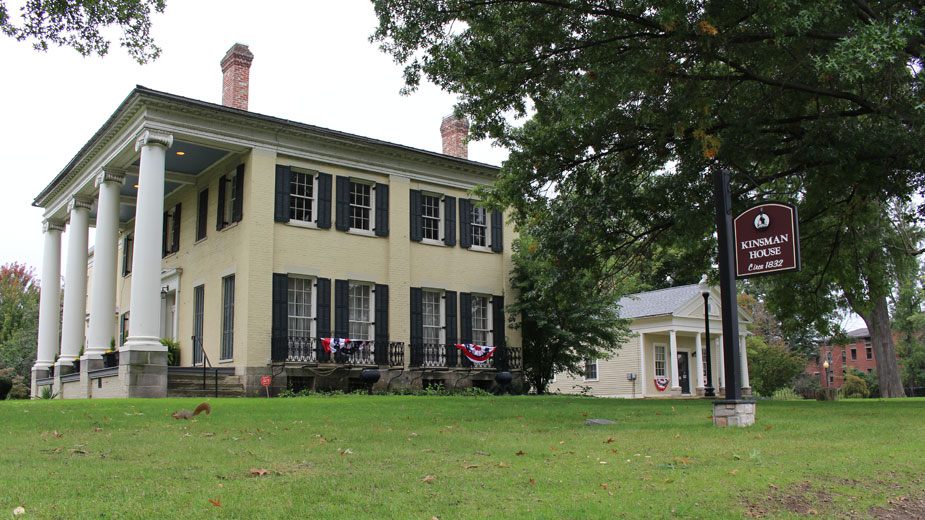Warren’s Millionaires Row Tells Nation’s Story
WARREN, Ohio – You don’t need to be well-versed in local history to appreciate the architectural beauty of the homes that line Warren’s Millionaires Row. But if you take the time to learn some of their stories, it’s easy to peel back the years and get glimpse of the wealthy, vibrant city that Warren was near the turn of the 20th century.
“Millionaires Row is to Warren what Euclid Avenue is to Cleveland or what Fifth Avenue is to New York,” says Meghan Reed, director of the Trumbull County Historical Society. “Mahoning Avenue is where the who’s who of Warren built their houses.”
Millionaires Row is the stretch of homes and buildings that run north along Mahoning Avenue starting at High Street. Most were built after the Civil War and were occupied by some of the most prominent names in Warren’s history.
Millionaires Row began to take shape in 1818 with the construction of the Warren-Ashtabula Turnpike, a toll road that allowed travelers to go from Warren to Lake Erie at a cost of one cent per mile.
“It was a wooden-planked road. One of very few that we had in this area,” Reed says.
The Mahoning Avenue corridor was well established by the 1870s, making it fertile ground for the city’s wealthy. Despite the description we use today, most weren’t millionaires. “We say ‘Millionaires Row’ because of that Gilded Age sort of opulence,” Reed says.
In 1910, the population of Warren was about 11,000, with about 3,500 of the residents working for one of the city’s 65 manufacturing companies.
Two of Warren’s biggest industries were automobile manufacturing and light bulbs.
At the start of the 20th century the city was home to around 12 car companies, including the Packard Motor Car Co., Sterling Knight, and the Trumbull Manufacturing Co.
Warren, or “Lampville USA” as a local paper dubbed it, was also home to more than a dozen light bulb manufacturers, making it the second largest producer of light bulbs in the country. It was also the first city to have incandescent streetlights.
In 1913, Warren’s first steel mill began operations.
“Warren really made it’s mark nationwide,” Reed says.
Heading north from downtown, the first prominent building you notice on your left is the Kinsman House, built in 1832 by General Simon Perkins as a wedding gift for his daughter, Olive.
Her husband, Frederick Kinsman, was a close family friend and also her first cousin.
“Back then when you wanted to keep the wealth in the family that’s what you did,” says Jim Valesky, president of the Warren Heritage Center.
Olive didn’t get to enjoy the mansion for long, however. She died at 28 after only six years of marriage.
“Some people say, and I agree with them, that she died from a broken heart,” Valesky says. “She wanted to raise children but none of them made it through infancy.”
Frederick, whose father, John Kinsman, first settled Kinsman Township, remarried in 1840. He would go on to be a judge, the original director of the Cleveland and Mahoning Valley Railroad, and a delegate to the Republican Party national convention that nominated President Abraham Lincoln for his second term.
The largest and most prominent building on Millionaires Row is the Presbyterian Church on the corner of High Street and Mahoning Avenue.
Founded by the Rev. Joseph Badger, a well-known missionary from New England who was among the first to arrive in the Connecticut Western Reserve, the church is the second oldest congregation in the city.
Next to the Kinsman House is Warren City Hall, an Italianate-style building built in 1871 by Henry Bishop Perkins, one of Warren’s most wealthy citizens.
“By 1871 the trend was really the bigger the better, the more opulent the better,” Reed says.
Perkins owned most of the land surrounding Warren and therefore had a big impact on the way the city grew. A firm believer in the Jeffersonian social philosophy of agrarianism, he envisioned Warren as a community made up of small farmers, and so, was unwilling to sell land to the manufacturing companies that were moving in.
“When you look at Niles or Youngstown, you’ll see a lot of their industry started growing within the heart of the city. But when you look at Warren, most of the industries here started growing around the outskirts,” Reed says.
But not all of the homes belonged to the ultra- wealthy. Many citizens were able to make a good enough living to afford a home on the prestigious boulevard.
“A few of the homes on Millionaires Row were owned by people who owned shops downtown and people who owned jewelry stores downtown,” Reed says.
One of them was Asael Adams, a skilled fur trapper who opened a general store on the corner of Main and Market streets. Unlike the Italianate-style preferred by Perkins, Adams’ home was built in the brick, Greek-revival style.
Beth Kotwis Carmichael, executive director of the Trumbull County Tourism Bureau, says the wide variety of architectural styles on Millionaires Row draws a lot of visitors to the area.
“We have visitors weekly who come in asking for information on the historic houses on Millionaires Row,” she says.
“A few weeks ago I had somebody from Erie, Pa., who came down specifically to look at the architecture,” she recalls.
What makes Warren’s Millionaires Row so special, Reed observes, is that so much has remained intact.
“There are a lot of homes that still exist and can remind us of those powerful and wonderful stories,” she says.
And those stories are a significant piece of the American narrative.
“When you think of this industrial heritage that made the United States, as a country, who we are today, we look at the places that boomed during the Industrial Revolution and Warren is an excellent example of that,” Reed says.
Pictured: The Kinsman House was built in 1832 by General Simon Perkins as a gift for his daughter, Olive, when she married Frederick Kinsman.
Copyright 2024 The Business Journal, Youngstown, Ohio.



